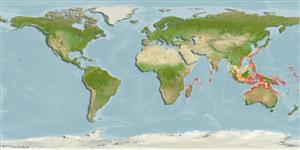Environment: milieu / climate zone / depth range / distribution range
Écologie
marin récifal; profondeur 5 - 40 m (Ref. 90102). Tropical
Indo-West Pacific: Madagascar to Indonesia and Australia (Ref. 2334, 3131).
Taille / Poids / Âge
Maturity: Lm ? range ? - ? cm
Max length : 65.0 cm SL mâle / non sexé; (Ref. 48637)
Épines dorsales (Total): 6 - 7; Rayons mous dorsaux (Total): 28-31; Épines anales 3; Rayons mous anaux: 19 - 23. Adults (above 40 cm) silvery, with dark bar through eye and another (faint) bar just behind head. Fins dusky. Small juveniles black, vertical white lines on body and fins. Subadults brown, with black bar from nape, over eye to chest and another black bar from dorsal-fin origin, over pectoral fins to pelvic fins, pectoral and pelvic fins dark brown or black. Body orbicular and strongly compressed, its depth more than twice length of head and 1.1 to 1.9 times in SL. Snout profile of large adults (above 40 cm) concave, with prominent bony swelling between eyes. Jaws with bands of slender, flattened, tricuspid teeth, the middle cusp 3 to 4 times longer than lateral cusps. Vomer with a band of strong teeth, no teeth on palatines. Five pores on each side of lower jaw. Preopercle smooth. Opercle without spines (Ref 43039).
Inhabits continental reefs (Ref. 9710). Adults usually moderately deep on open substrates with sparse reef or coral heads. A solitary species, but occasionally in pairs or small groups. Small juveniles also in deep water and the zebra-pattern serves well as camouflage when sheltering with crinoids (Ref. 48637). Juveniles in shore waters; adults in deeper water.
Life cycle and mating behavior
Maturité | Reproduction | Frai | Œufs | Fécondité | Larves
Sainsbury, K.J., P.J. Kailola and G.G. Leyland, 1985. Continental shelf fishes of the northern and north-western Australia. An illustrated guide. CSIRO Division of Fisheries Research; Clouston & Hall and Peter Pownall Fisheries Information Service, Canberra, Australia. 375 p. (Ref. 3131)
Statut dans la liste rouge de l'IUCN (Ref. 130435)
Menace pour l'homme
Harmless
Utilisations par l'homme
Aquarium: Commercial
Plus d'informations
Noms communsSynonymesMétabolismePrédateursÉcotoxicologieReproductionMaturitéFraiRassemblement de ponteFéconditéŒufsDéveloppement de l'œuf
RéférencesAquacultureProfil d'aquacultureSouchesGénétiqueElectrophoresesHéritabilitéPathologiesTraitementNutrientsMass conversion
CollaborateursImagesStamps, Coins Misc.SonsCiguateraVitesseType de nageSurface branchialeOtolithesCerveauxVision
Outils
Articles particuliers
Télécharger en XML
Sources Internet
Estimates based on models
Preferred temperature (Ref.
123201): 25.1 - 29, mean 27.9 °C (based on 558 cells).
Phylogenetic diversity index (Ref.
82804): PD
50 = 0.5313 [Uniqueness, from 0.5 = low to 2.0 = high].
Bayesian length-weight: a=0.02692 (0.01137 - 0.06373), b=2.94 (2.74 - 3.14), in cm total length, based on LWR estimates for this (Sub)family-body shape (Ref.
93245).
Niveau trophique (Ref.
69278): 3.5 ±0.37 se; based on food items.
Résilience (Ref.
120179): Faible, temps minimum de doublement de population : 4,5 à 14 années (Preliminary K or Fecundity.).
Fishing Vulnerability (Ref.
59153): Moderate to high vulnerability (52 of 100).
Nutrients (Ref.
124155): Calcium = 31.7 [16.8, 52.8] mg/100g; Iron = 0.472 [0.288, 0.735] mg/100g; Protein = 18.8 [17.6, 19.9] %; Omega3 = 0.0935 [, ] g/100g; Selenium = 36.6 [20.8, 64.8] μg/100g; VitaminA = 45.6 [13.6, 147.6] μg/100g; Zinc = 0.924 [0.657, 1.303] mg/100g (wet weight);
